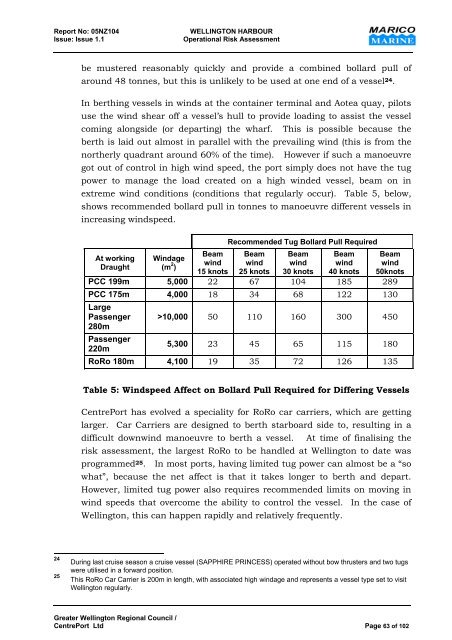MARICO Marine NZ Limited WELLINGTON HARBOUR PORT AND ...
MARICO Marine NZ Limited WELLINGTON HARBOUR PORT AND ...
MARICO Marine NZ Limited WELLINGTON HARBOUR PORT AND ...
Create successful ePaper yourself
Turn your PDF publications into a flip-book with our unique Google optimized e-Paper software.
Report No: 05<strong>NZ</strong>104 <strong>WELLINGTON</strong> <strong>HARBOUR</strong><br />
Issue: Issue 1.1 Operational Risk Assessment<br />
be mustered reasonably quickly and provide a combined bollard pull of<br />
around 48 tonnes, but this is unlikely to be used at one end of a vessel24. In berthing vessels in winds at the container terminal and Aotea quay, pilots<br />
use the wind shear off a vessel’s hull to provide loading to assist the vessel<br />
coming alongside (or departing) the wharf. This is possible because the<br />
berth is laid out almost in parallel with the prevailing wind (this is from the<br />
northerly quadrant around 60% of the time). However if such a manoeuvre<br />
got out of control in high wind speed, the port simply does not have the tug<br />
power to manage the load created on a high winded vessel, beam on in<br />
extreme wind conditions (conditions that regularly occur). Table 5, below,<br />
shows recommended bollard pull in tonnes to manoeuvre different vessels in<br />
increasing windspeed.<br />
At working<br />
Draught<br />
Windage<br />
(m 2 )<br />
Beam<br />
wind<br />
15 knots<br />
Recommended Tug Bollard Pull Required<br />
Beam<br />
wind<br />
25 knots<br />
Beam<br />
wind<br />
30 knots<br />
Beam<br />
wind<br />
40 knots<br />
Beam<br />
wind<br />
50knots<br />
PCC 199m 5,000 22 67 104 185 289<br />
PCC 175m 4,000 18 34 68 122 130<br />
Large<br />
Passenger<br />
280m<br />
Passenger<br />
220m<br />
>10,000 50 110 160 300 450<br />
5,300 23 45 65 115 180<br />
RoRo 180m 4,100 19 35 72 126 135<br />
Table 5: Windspeed Affect on Bollard Pull Required for Differing Vessels<br />
CentrePort has evolved a speciality for RoRo car carriers, which are getting<br />
larger. Car Carriers are designed to berth starboard side to, resulting in a<br />
difficult downwind manoeuvre to berth a vessel. At time of finalising the<br />
risk assessment, the largest RoRo to be handled at Wellington to date was<br />
programmed25. In most ports, having limited tug power can almost be a “so<br />
what”, because the net affect is that it takes longer to berth and depart.<br />
However, limited tug power also requires recommended limits on moving in<br />
wind speeds that overcome the ability to control the vessel. In the case of<br />
Wellington, this can happen rapidly and relatively frequently.<br />
24<br />
During last cruise season a cruise vessel (SAPPHIRE PRINCESS) operated without bow thrusters and two tugs<br />
were utilised in a forward position.<br />
25<br />
This RoRo Car Carrier is 200m in length, with associated high windage and represents a vessel type set to visit<br />
Wellington regularly.<br />
Greater Wellington Regional Council /<br />
CentrePort Ltd Page 63 of 102
















